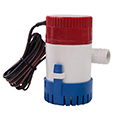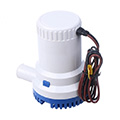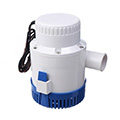Bilge Pump Price List
A bilge pump is a mechanical device designed to remove water that accumulates in the bilge of a ship or boat. The bilge is the lowest compartment on a vessel's hull, and it often collects water, oil, and other fluids that may enter the ship due to leaks, rain, or other sources. The primary purpose of a bilge pump is to prevent the accumulation of water in the bilge, helping to keep the ship afloat and maintaining a safe operating environment.
Bilge pumps play a crucial role in maritime safety, as excessive water in the bilge can lead to instability, reduced buoyancy, and potential sinking. They are a vital component of a ship's bilge system, which also includes bilge alarms, float switches, and other monitoring devices to ensure prompt detection and response to water accumulation.
In automation online store, you can find the high quality and reasonable price bilge pump. In the following, we will show you our price list.
Bilge Pump Price List:
| Product | SKU | Voltage | Capacity | Price |
 |
ATO-BP-350 | 12V | 350 gph | $79.06 |
| ATO-BP-500 | 12V/24V | 500 gph | $81.20 | |
| ATO-BP-750 | 12V/24V | 750 gph | $82.97 | |
| ATO-BP-1100 | 12V/24V | 1100 gph | $84.65 | |
 |
ATO-BP-1500 | 12V/24V | 1500 gph | $137.46 |
| ATO-BP-2000 | 12V/24V | 2000 gph | $139.73 | |
 |
ATO-BP-3000 | 12V/24V | 3000 gph | $167.09 |
| ATO-BP-3500 | 12V/24V | 3500 gph | $169.83 | |
| ATO-BP-3700 | 12V/24V | 3700 gph | $172.69 |
What are the advantages of bilge pump?
- Preventing Water Accumulation. The primary purpose of a bilge pump is to prevent water from accumulating in the bilge. This accumulation can result from various sources, such as rainwater, seawater ingress, or leakage from plumbing systems. By efficiently removing this water, the portable bilge pump helps in maintaining the vessel's buoyancy and stability.
- Enhancing Safety. Safety is paramount at sea, and a bilge pump plays a crucial role in preventing the risk of a vessel sinking due to water ingress. Timely removal of water from the bilge ensures that the ship maintains its intended floatation level, reducing the likelihood of capsizing or sinking in adverse conditions.
- Protecting Structural Integrity. Prolonged exposure to water can compromise the structural integrity of a vessel. By promptly pumping out accumulated water, a marine bilge pump helps prevent corrosion and deterioration of the hull, preserving the overall strength and durability of the ship.
- Avoiding Damage to Equipment. Many vessels house essential machinery and equipment in the lower compartments. Accumulated water in the bilge can damage or impair the functionality of these systems. Bilge pumps play a vital role in protecting valuable equipment by keeping the bilge dry and preventing potential water damage.
- Emergency Situations and Flooding Mitigation. In the event of a sudden influx of water due to a leak, collision, or other emergencies, small bilge pumps are crucial for quickly mitigating flooding. Their rapid water removal capabilities can buy valuable time for the crew to address the root cause of the issue and take necessary actions to control the situation.
Larger vessels often employ centrifugal or diaphragm pumps as primary bilge pump systems. Centrifugal pumps work by using a rotating impeller to create a flow of water, while diaphragm pumps use a flexible diaphragm to generate suction and discharge. These pumps may be engine-driven or require a power source from the boat's electrical system.
Additionally, boats often have a backup or secondary bilge pump to provide redundancy in case the primary pump fails. This redundancy is critical for safety at sea, where rapid water ingress can lead to catastrophic consequences. Some advanced bilge pump systems also include automatic sensors or float switches that activate the pump when the water level in the bilge reaches a certain threshold. This automation ensures a timely response to potential flooding, even if the crew is not actively monitoring the bilge.
Regular maintenance of bilge pumps is essential to ensure their proper functioning. This includes periodic inspection, cleaning, and testing of the pump and associated components. It is also crucial to keep the bilge area free from debris and contaminants that could hinder pump performance. In addition to mechanical maintenance, boat owners should check electrical connections, batteries, and other components to ensure the reliability of the pump system.

